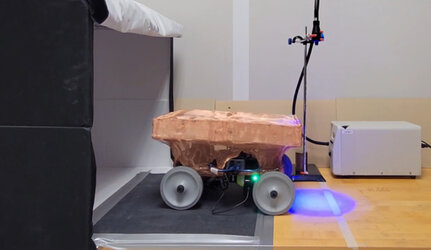
Nobody knows what sleeping mushrooms dream of when their vast mycelial networks flicker and pulse with electrochemical responses akin to those of our own brain cells.
But given a chance, what might this web of impulses do if granted a moment of freedom?
An interdisciplinary team of researchers from Cornell University in the US and the University of Florence in Italy took steps to find out, putting a culture of the edible mushroom species Pleurotus eryngii (also known as the king oyster mushroom) in control of a pair of vehicles, which can twitch and roll across a flat surface.
Through a series of experiments, the researchers showed it was possible to use the mushroom's electrophysiological activity as a means of translating environmental cues into directives, which could, in turn, be used to drive a mechanical device's movements.
"By growing mycelium into the electronics of a robot, we were able to allow the biohybrid machine to sense and respond to the environment," says senior researcher Rob Shepherd, a materials scientist at Cornell.
Melding meat with machine is nothing new. Evolution has had hundreds of millions of years to fine-tune organic machines, so it's only natural we'd turn to biology for short-cuts on making robust devices that can sense, think, and move how we want.
Surprisingly, the Fungi kingdom is something of an untapped goldmine for cybernetic technology. Easily cultured with relatively simple requirements and a propensity to survive where many other organisms would struggle, molds and mushrooms could provide engineers with a variety of robust living components to suit just about every sensory or even computational need.
Often hidden from view, networks of fine fungal threads respond to changes in their surroundings as they weave through the soil in search of resources. A number of species even crackle with transmembrane activity that resembles our own neural responses, providing researchers with a potential means of eavesdropping on their secret conversations.
By applying algorithms based on the extracellular electrophysiology of P. eryngii mycelia and feeding the output into a microcontroller unit, the researchers used spikes of activity triggered by a stimulus – in this case, UV light – to toggle mechanical responses in two different kinds of mobile device.

In controlled experiments, the team used the signals from a fungal culture to govern the movements of a five-limbed soft robot and a four-wheeled untethered vehicle.
They were able to influence and override the 'natural' impulses produced by the fungi, demonstrating an ability to harness the system's sensory abilities to meet an end goal.
"This kind of project is not just about controlling a robot," says Cornell bioroboticist Anand Mishra.
"It is also about creating a true connection with the living system. Because once you hear the signal, you also understand what's going on. Maybe that signal is coming from some kind of stresses. So you're seeing the physical response, because those signals we can't visualize, but the robot is making a visualization."
As clumsy as 'roboshroom' might look, the true value of the system may one day be realized in simpler mechanical setups that interpret complex shifts in environmental cues to deliver precise amounts of nutrient or pesticide to a soil environment, or automatically tailor responses to rising levels of pollutant or even react to changes in our own bodies.
There's a deeper wisdom in the whispers of mushrooms we're only just beginning to understand. Given an opportunity, they might even one day tell us what they're dreaming.